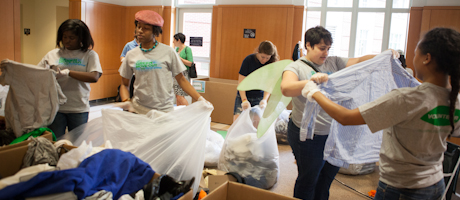GW rising senior Julia Simon sorted clothes in the lobby of Ivory Tower residence hall, separating out those for men and for women and bagging the men’s clothing especially for So Others Might Eat (SOME), a Washington, D.C., charity that provides both emergency and long-term services to homeless district residents.
“I wanted to help give back to those who aren’t as fortunate as me, and GW makes it easy to get involved by putting donation boxes in the dorms,” Ms. Simon said, as she dropped a plaid men’s button-down shirt into a nearly full bag. She was one of nearly 600 volunteers—GW students, faculty members and staff—who pitched in for GW’s 2012 Green Move-Out program.
Green Move-Out, now it its sixth year, is an initiative to encourage students vacating GW residence halls to donate unwanted new and gently used items to charity. The program keeps the material out of landfills while supporting 10 local organizations—from homeless-service providers like SOME to animal shelters, food banks and the National Children’s Center, which supports children and adults with developmental disabilities.
“If we make D.C. better, we make campus better,” said Cricket Manjarrez, GW’s preventative maintenance coordinator and a cochair of Green Move-Out for 2012. “I really like working with SOME and other local charities. There are needs that you see in D.C., and this is a chance to fulfill those needs directly. And service is one of our core values.”
This year, Green Move-Out collected about 90,000 pounds of clothing, shoes, and bedding—more than 3,600 bags, each weighing about 25 pounds. More than 5,000 pounds of nonperishable food were collected, in addition to 57 boxes of books, weighing 35 pounds each. Students also donated large household items—34 televisions, eight futons and numerous small lamps, vacuum cleaners and shelving units. Trucks arrived to collect donations on an almost-daily basis between April 30 and May 23, with twice-daily pickups scheduled after Commencement when seniors vacated their residence halls.
Greg Chudy, donations coordinator at SOME, said his organization reaps great benefits from partnering with GW during Green Move-Out. SOME’s wish list for its clients includes sheets, towels and clothing—especially men’s clothing—as well as kitchen wares, small household necessities and nonperishable food.
SOME operates a free “clothing room” where homeless men and women can come to get clean clothing, as well as a shower room where they can take hot showers.
“Most of our clients do not have access to washing machines on a regular basis, so they rely on the clothing room to remain presentable,” Mr. Chudy said. “We get between 40 and 50 men each day, and 10 to 20 ladies, so you can imagine the volume of clothing we distribute.”
In addition to serving the homeless, SOME also runs programs to help people transition into lives of greater stability. These programs, too, benefit from the types of donations collected at Green Move-Out.
“We help people moving out of shelters who can’t afford to furnish an apartment with the basics,” Mr. Chudy explained. “We have a warehouse where they can come and pick out what they need. We give them the necessities free of charge, and we get a lot from the move-out programs.”
The Green Move-Out 2012 charity partners—which also included the Capital Area Food Bank, Washington Animal Rescue League, Miriam’s Kitchen, Turning the Page, and others—are able to accept most of the materials that students donate, Ms. Manjarrez said. Even things that students aren’t supposed to have in residence halls, such as hot pots and other electrical appliances, are donated if they turn up in collection boxes. Blankets, pillows and other bedding are especially valuable to animal shelters, which use the items to make beds for the animals they rescue.
Even the unusual items are generally put to good use. This year, for example, the donation boxes turned up 19 crutches, a witch’s broom from a Halloween costume, a pair of fairy wings and a stuffed sloth. Items that aren’t suitable for direct donation can go to the National Children’s Center, which sells some donations in resale shops to raise money for its programming.
Ms. Manjarrez said this year’s Green Move-Out was especially successful because of the volunteers’ hard work.
“We had a lot of support from students and faculty this year, and we were able to retain more [donations], rather than letting it go to waste. In the past, we’ve run out of volunteers and time at the end. This time we had great organization and people working really hard,” she said.
Junior Jamila Kerr volunteered to help out with Green Move-Out when she realized she’d be on campus an extra week after finishing her exams.
“I wanted to do something useful,” she said. “I already did a lot of sleeping!”


